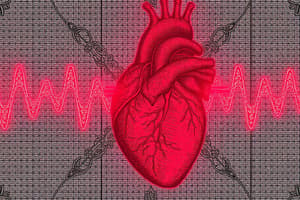Podcast
Questions and Answers
What are the components of ECG?
What are the components of ECG?
- P Wave (correct)
- PR Segment (correct)
- T Wave (correct)
- QRS Complex (correct)
What does the P Wave represent?
What does the P Wave represent?
Atrial depolarization
What occurs during the PR segment?
What occurs during the PR segment?
Electrical inactivity between the P wave and the QRS complex
What does the QRS complex represent?
What does the QRS complex represent?
What is indicated by a wide QRS?
What is indicated by a wide QRS?
What does the T wave represent?
What does the T wave represent?
What is the ST segment?
What is the ST segment?
The _____ uses heart rate as one of three criteria to identify treatable arrhythmias.
The _____ uses heart rate as one of three criteria to identify treatable arrhythmias.
How do you calculate heart rate using the Six Second Strip Method?
How do you calculate heart rate using the Six Second Strip Method?
What do you assess to determine if the rhythm is regular?
What do you assess to determine if the rhythm is regular?
What indicates a QRS complex is wide?
What indicates a QRS complex is wide?
How is the width of the QRS complex calculated?
How is the width of the QRS complex calculated?
What indicates a normal QRS width?
What indicates a normal QRS width?
What must be verified to assess if every QRS is associated with a P wave?
What must be verified to assess if every QRS is associated with a P wave?
Flashcards are hidden until you start studying
Study Notes
Components of ECG
- ECG consists of P wave, PR segment, QRS complex, T wave, and ST segment.
P Wave
- First wave in ECG sequence, indicating atrial depolarization.
- Typically shows an upward deflection.
PR Segment
- Represents electrical inactivity between P wave and QRS complex.
- Indicates conduction delay between AV node and Bundle of HIS, allowing atrial contraction before ventricular contraction.
- May be indistinguishable at high heart rates.
QRS Complex
- Reflects ventricular depolarization; larger than P wave due to greater ventricular muscle mass.
- Shows speed and direction of electrical impulse through ventricles; wide QRS signifies poor conduction and pumping strength.
QRS Appearance
- Q wave is present if the first deflection points downward.
- R wave denotes the first upward deflection in the complex.
- S wave follows R wave with a downward deflection.
T Wave
- Represents ventricular repolarization; heart reset for receiving new impulses.
- Cannot respond to another impulse until repolarization finishes; may appear elevated or inverted.
ST Segment
- Lies between the end of the QRS complex and the beginning of the T wave.
- Should align with the baseline in a healthy heart rhythm.
Interpreting ECG
- Key assessment questions:
- What is the heart rate?
- Is the rhythm regular?
- Is the QRS complex wide?
- Does every QRS have a corresponding P wave?
Importance of Heart Rate
- LifeVest monitors heart rate as one of three criteria for identifying treatable arrhythmias.
- Treatment thresholds are evaluated for ventricular tachycardia (VT) and ventricular fibrillation (VF) based on heart rate.
Six Second Strip Method
- Count number of QRS complexes over a six-second interval.
- Multiply the count by ten to estimate heart rate.
Rhythm Regularity
- Examine R-R intervals, the distance between R waves.
- Consistent R-R intervals indicate a regular rhythm, crucial for diagnosing arrhythmias.
Measuring QRS Width
- Wide QRS complex suggests the rhythm may originate in the ventricles.
- QRS width measured from the start of Q or R wave to the end of S wave.
Calculating QRS Width
- Count small boxes between Q (or R) and S waves; multiply by 0.04 seconds.
- Each small box represents 0.04 seconds.
Normal QRS
- A normal QRS width is ≤ 0.12 seconds (3 small boxes).
- Indicates electrical impulses come from above the ventricles through the AV node.
Wide QRS
- Defined as QRS width > 0.12 seconds (3 small boxes).
- Can result from conduction delays in ventricles or originate from ventricles themselves.
- The association of P waves and the QRS width aids in diagnosing the cause.
Associating QRS and P Wave
- Check if each QRS complex is preceded by a P wave.
- Ensure consistency of the PR interval between complexes.
- Relationship between QRS and P wave, along with QRS width, helps infer the rhythm's origin.
Studying That Suits You
Use AI to generate personalized quizzes and flashcards to suit your learning preferences.




